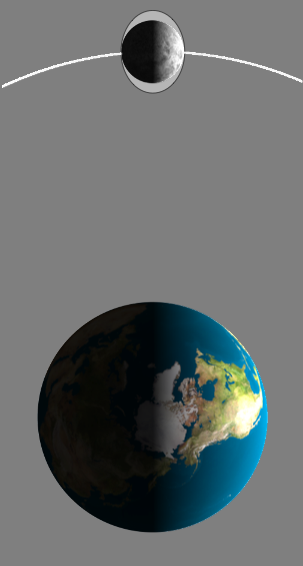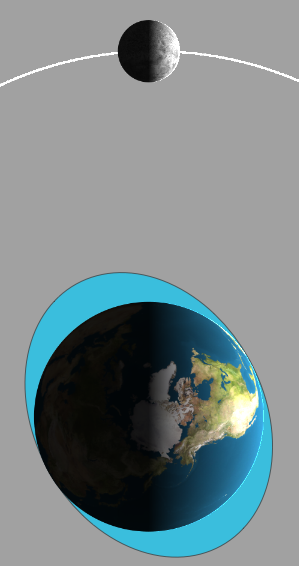FAQ – Earth & Moon
Let’s do some math. As a target, you need to determine the cross-section of the Moon (target Moon is a disk). The radius of the Moon is 1,737 km, so its cross-sectional area is 9.5 X 106 km2. The area of a sphere at the distance of the Moon (384,400 km) is 1.9 X 1012 km2. Therefore, if something were to pass by the Moon’s orbit on the way to the Earth, the chances of hitting the Moon would be the ratio of target Moon to the area of a sphere at the distance of the Moon: 1/200,000. Not very good protection!
Looking at pictures and doing an activity that has you as the Earth looking at the positions of the Moon and Sun really helps. The thing to remember is that the Moon is a ball being lit up by the distant Sun (always half illuminated and always in the direction of the Sun). From the Earth, as the Moon goes around, how much of the lit side of the Moon do you see? Practice, practice, practice.
The Moon orbits the Earth and the Earth-Moon system orbits the Sun. The nodes are the points in the orbit of the Moon where it crosses the orbit of the Earth-Moon system around the Sun. When the Moon is at one of these nodes, the Moon, Earth, and Sun are lined up so that an eclipse can occur.
Yes, it is gravity. Recall how a tightrope walker is stabilized by holding a long pole. In this case, gravity is pulling down on the pole and it takes more force (torque) to turn the pole (and the person with it). It is the same thing with a spinning bicycle wheel. The torque keeps the wheel upright and you from falling off the bike. In the same way, the Moon going around the Earth is like the spinning wheel—it takes more force to move the axis of the Earth because of the gravitational pull of the Moon on the Earth (torque).
Since tides are caused by the pull of gravity from the Moon and the Sun, when the Moon is at perigee (closest to Earth), the tides are stronger than when the Moon is at apogee (farthest from Earth), but the difference is only a few percent.
We’re all familiar with the concept of ocean tides, but tides also occur in a dry rocky body. Earth raises tides on the Moon, resulting in the shape of the Moon being very slightly non-spherical, with a tidal bulge aligned in the direction of Earth and a second tidal bulge on the opposite sides of the Moon.
The Moon raises tides on Earth. Because Earth rotates faster than the Moon orbits (24 hours vs. 27 days) our planet forces the position of high-tide to occur ahead of where the moon is, not directly below the moon (see diagram). Basically, Earth is pushing the high tide ahead of the Moon. It takes energy for Earth to push the tide ahead like this and every time an ocean tide meets a continent much of that energy is lost. Thus, tides are draining energy out of Earth’s rotation, slowing it down. Because of this loss of rotational energy in about a billion years or so Earth will rotate at the same rate that the Moon orbits it. They will both keep the same sides facing each other. This is the current configuration of the Pluto-Charon system. Also, a few billion years ago the same tidally-driven loss of rotational energy slowed down the Moon until it kept the same side facing Earth. Tides raised on the Moon by Earth caused that to happen (note that tides on the Moon occur in the rocky crust).


Yes, in a couple billion years or so tides on Earth raised by the Moon will have slowed our planet down enough such that both the Moon and Earth keep the same sides facing each other. In other words, Earth’s rotation rate will be equal to the Moon’s orbital period (about 27 days now). Once Earth gets into this configuration you can imagine the change in weather patterns that would result. The night side would cool off significantly during the long period without solar heating. Conversely, the day side would heat up more than it presently does. This difference in heating and cooling may result in strong atmospheric winds blowing from the hot daytime side to the cold nighttime side. In addition, geographically speaking there will no longer be high tides “coming in” and “going out” because the position of the tides will be fixed with respect to the continents.
The moon will continue to move farther away from Earth until the Earth’s rotation has slowed to the point where both the Moon and Earth keep the same sides facing each other at all times. But the story doesn’t end there. Earth will continue to slow down because of tides raised on Earth by the Sun. As Earth begins rotating more slowly than the Moon orbits, the influence of tides will cause the Moon to start getting closer to Earth. This is currently happening to the Martian moon Phobos. Phobos orbits Mars faster than Mars rotates and tides on Mars are causing Phobos to move slowly towards the red planet. For the Earth-Moon system, in a few billion years our Moon will be so close to Earth that Earth’s gravity pulls it apart. When that happens the debris from the Moon will form a ring system around Earth much like Saturn’s ring system. The image below is what Earth might look like in a few billion years with a ring system and continents in a totally different configuration than today because of plate tectonics.

Tidal waves, or tsunamis, are actually due to underwater earthquakes and so they are unrelated to the pull of the Moon on the Earth (though some scientists have been looking to see if the pull of the Moon can trigger earthquakes—the answer is probably no or at least the evidence is not convincing). The Moon does, however, cause tides whose height is greatly influenced by local topography. Tides are caused by a combination of the pull of the Moon and the pull of the Sun. Ideally (if there was no land and the water was uniformly thick), the lunar tide would be 54 cm and the solar tide would be 25 cm. So, if they pulled together, the maximum tide would be 79 cm. However, because the Moon and the Sun are sometimes closer to the Earth, this can be up to 94 cm. Now, when you add the land, things change. Water can be funneled into the Bay of Fundy where high tides can average nearly 17 meters! There are also atmospheric tides and land tides. Land tides are about 55 cm (15 cm due to the Sun). Does the cycle of the Moon affect the human psyche? Some people say yes, others no. The word lunatic relates to the Moon, but I do not think that anything has really been proven.
